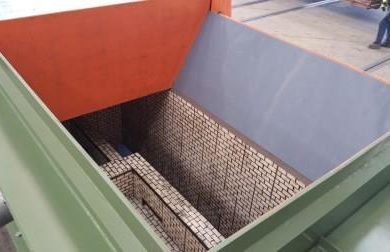Under increasing pressure to maximize income from mining, optimize operational excellence and find new productivity gains, operators can ill afford to exhaust equipment or rely on under-performing components. Avoiding costly emergency shutdowns and breakdowns is a priority, especially when mining in demanding conditions and trying to meet the need for higher flow rates. While extending maintenance intervals can have a positive impact on the operators’ bottom line.
Downtime is a significant issue and operators are always looking for ways to enhance availability in the equipment that breaks and processes materials. Therefore, components used must guarantee optimum performance and reliability, so that unexpected maintenance or replacement is minimized.
Zane Thomas, Technical Manager for Trelleborg’s engineered products operation, discusses the importance of chute lining design to ensure the optimum flow rate of minerals and prevent extended downtime caused by excessive build up.
Mine chute performance and upkeep are critical to a project. Liners play an important role in protecting chute walls from impact and wear.
One of the core issues is the management of wet and sticky ores, which is compounded when mine chutes are tasked with handling larger flow rates. A common obstacle to hitting process and production targets lies in the very nature of wet materials. They stick to surfaces, especially chute wall liners, forming uneven lumps that clog and impede the flow of materials, resulting in decreased process rates.
Traditional liners used in chutes have been simple rubber designs that simply protect the chute walls from abrasion and damage. However, a large oversight lies in the fact that wet and sticky ores striking the liners tend to stick to them, creating uneven gaps in flow rates.
In addition, chute lining systems are difficult to install and remove. So extended downtime is not uncommon, due to the time taken to safely swap out chute liners. This is one of the issues Trelleborg sought to overcome for a customer in Australia.
The company recently designed a chute lining system that was quick and easy to install for a port facility in the Pilbara region of Western Australia. After closely working with the project’s engineers, Trelleborg’s engineering team designed an innovative, new Flexible Chute Lining System that facilitates the free flow of materials in this high capacity mining application and overcomes build-up problems in mine chutes.
Keeping the customer’s ultimate objectives in mind, Trelleborg designed and fabricated a made-to-measure system. The modular solution is made up of self-energized rubber panels, or fingers that simplify the replacement of worn panels during maintenance or repair. With no scaffolding on the outside of the chute required, installation and maintenance is easier and quicker, while labor and scaffolding costs are also significantly reduced.
In this instance, the engineering team designed a hanger bracket system to fit into the existing hole configuration of the chute, delivering a flexible build-up resistant liner package. Ceramic in the liner material significantly improves wear resistance, durability and keeps wet, sticky materials travelling through chutes. This reduces the need for planned maintenance and lowers the risk of breakdown.
Feedback on the installation system at the port has been extremely positive, thanks in part to the system being so easy to use – fittings were perfect when the system was delivered and not a single modification was required.










